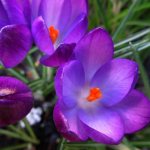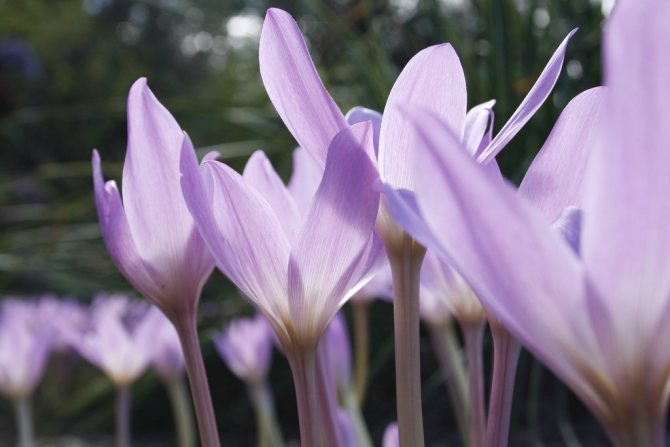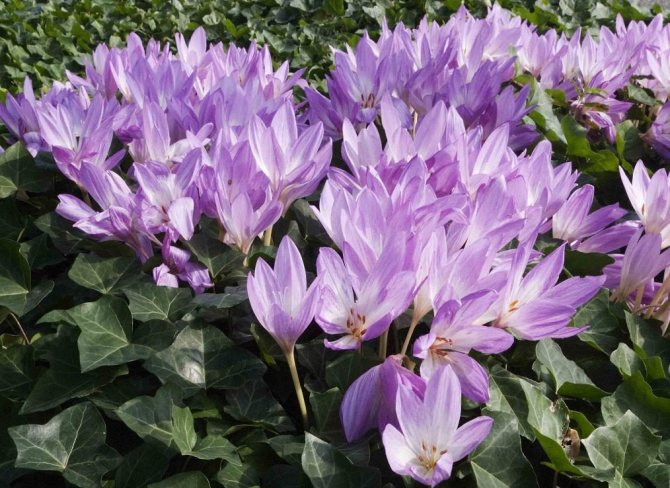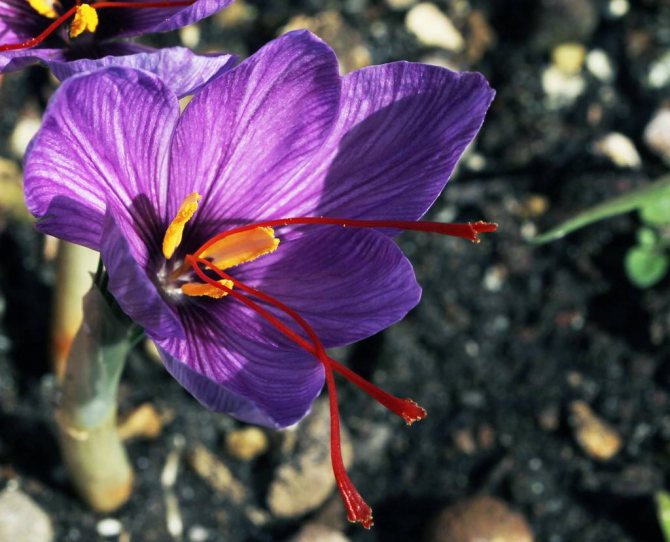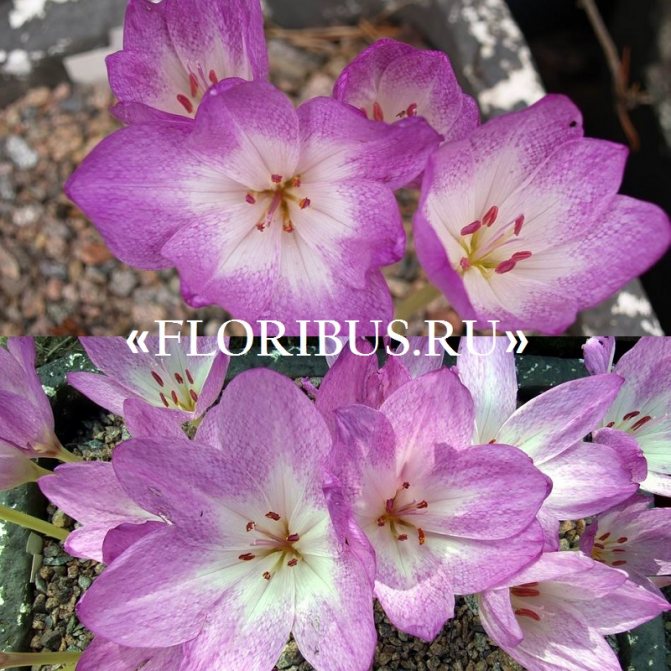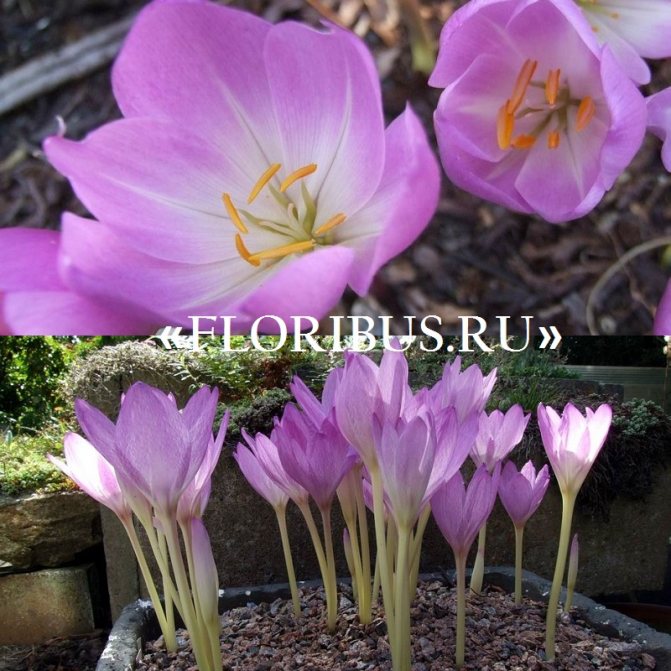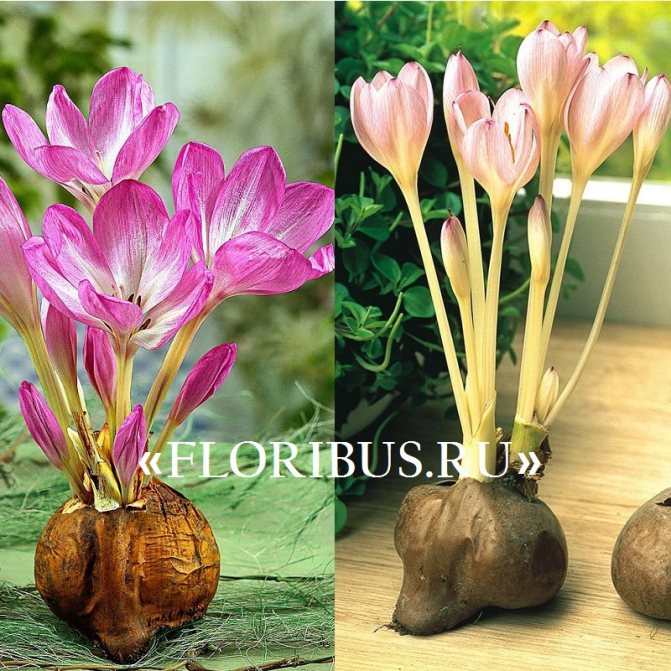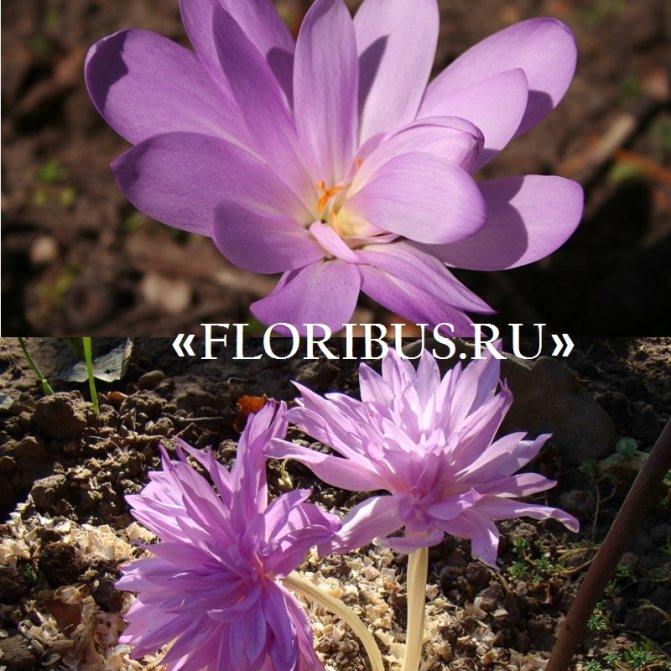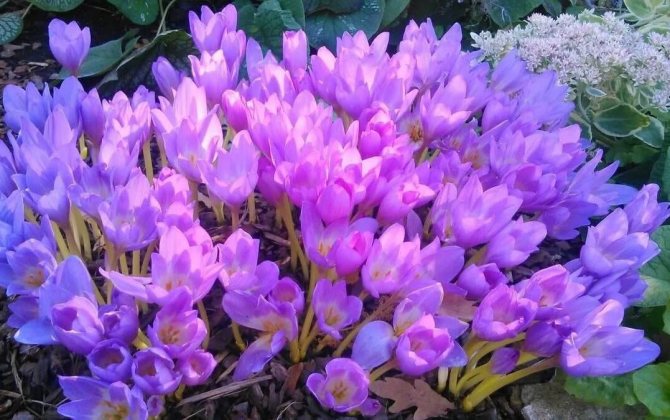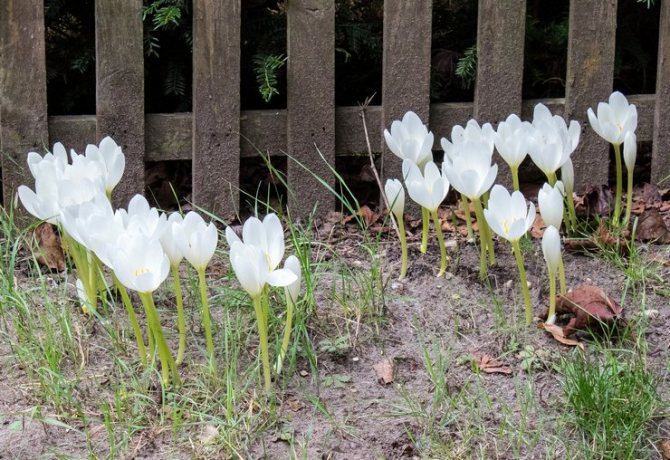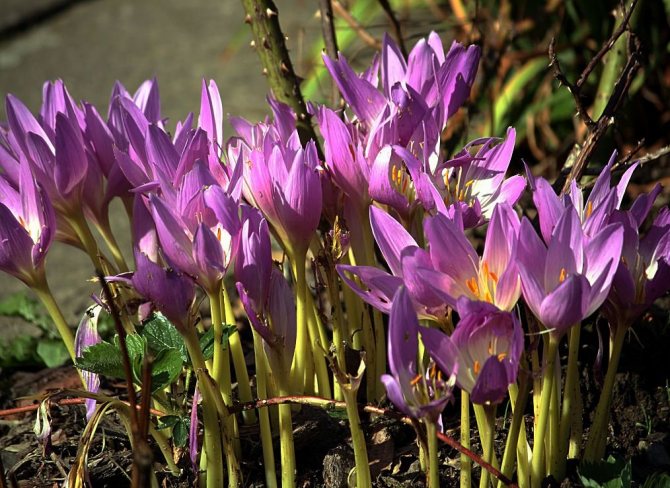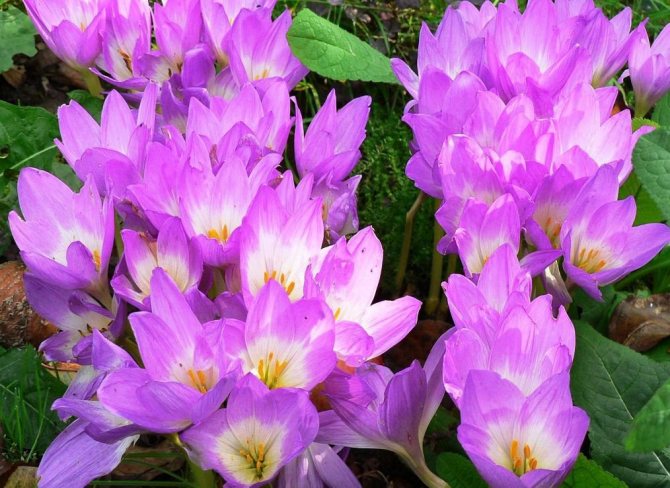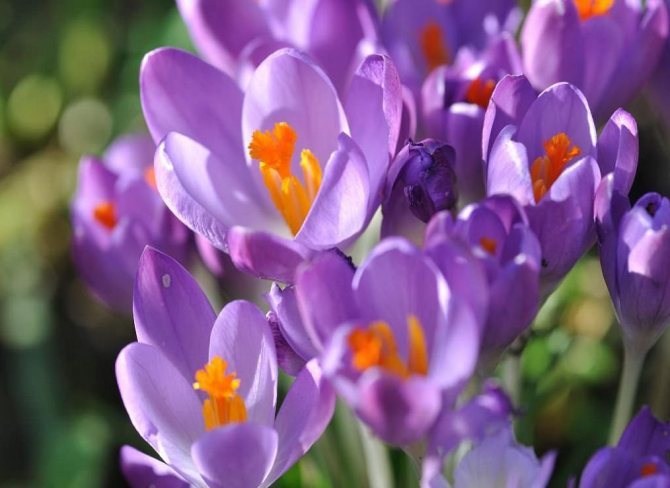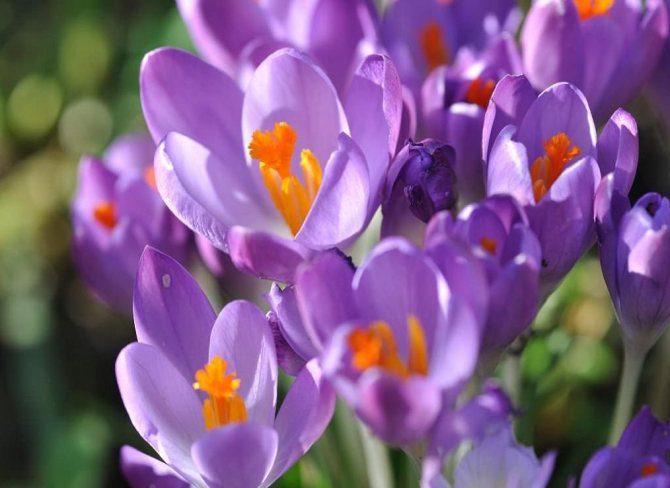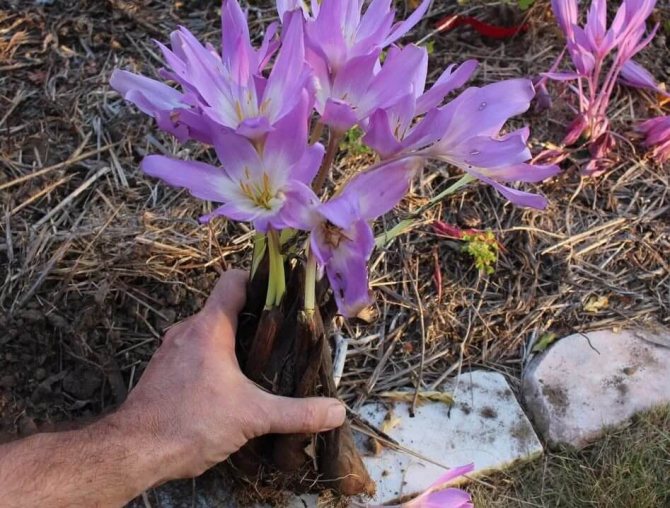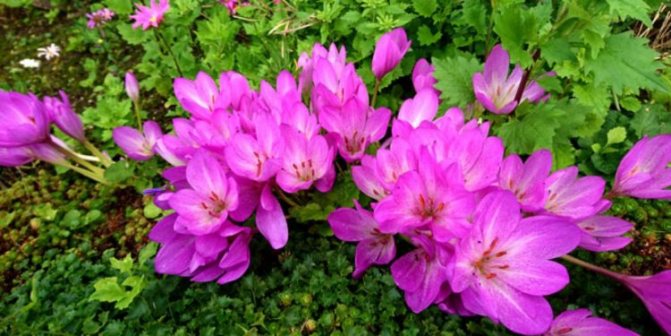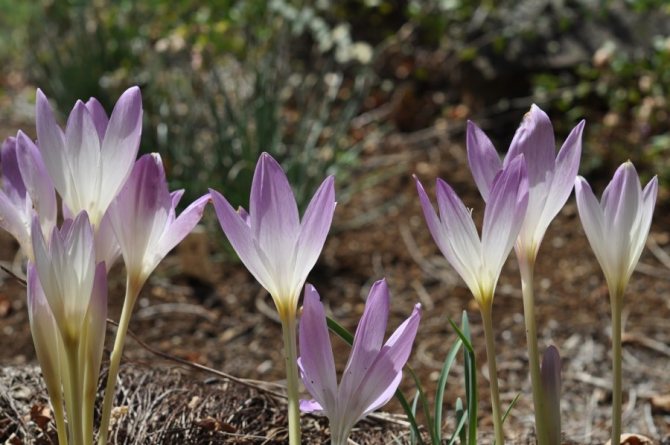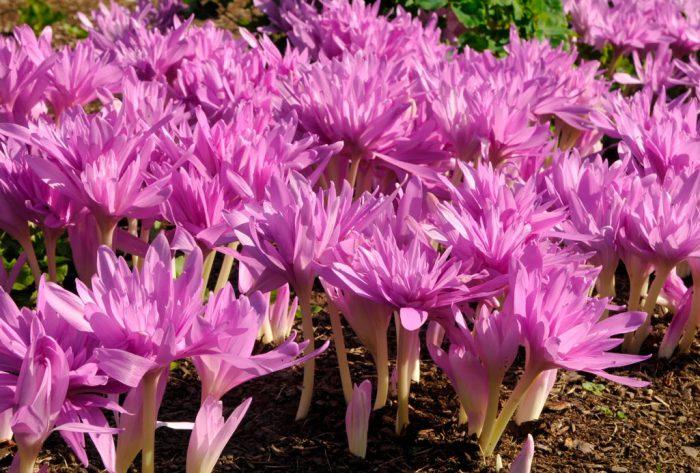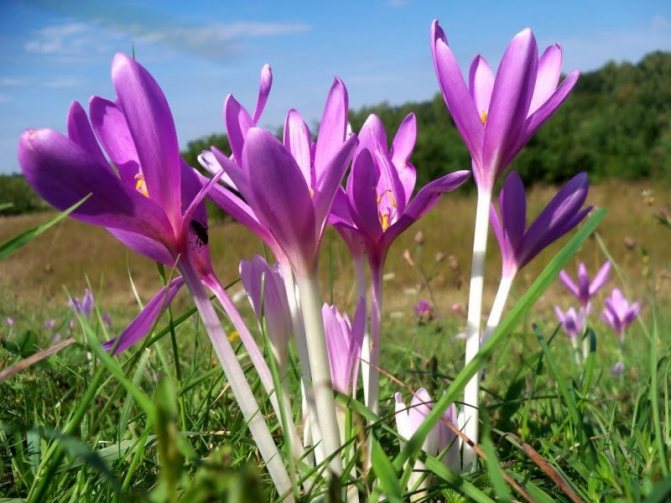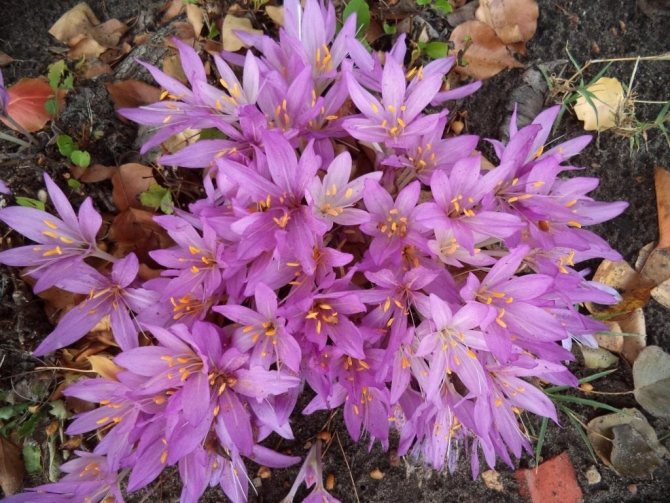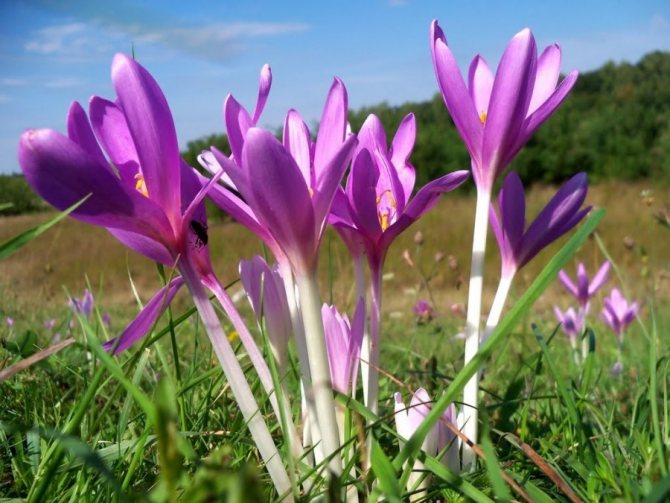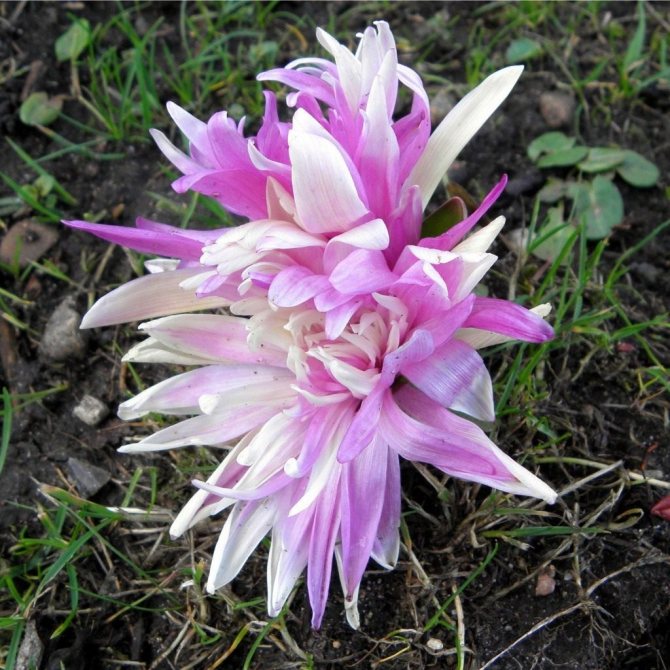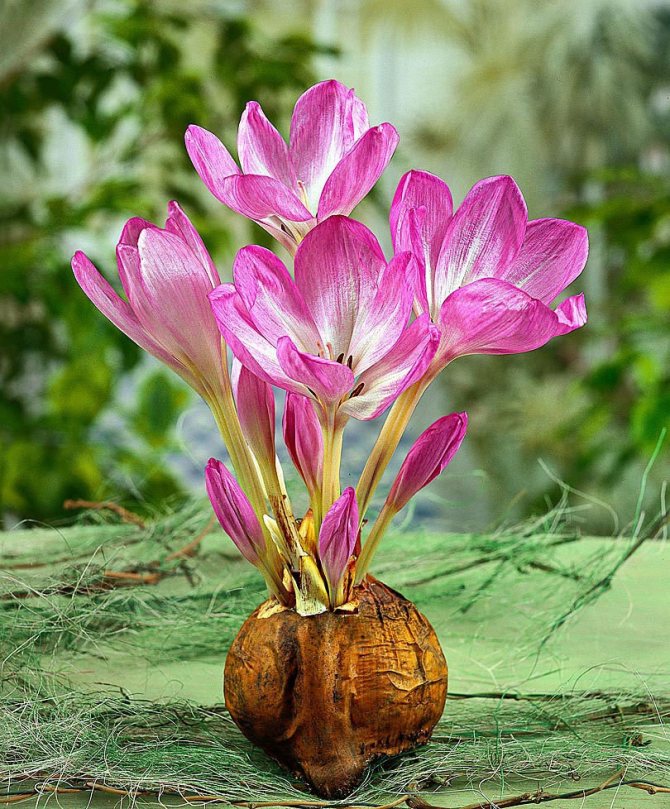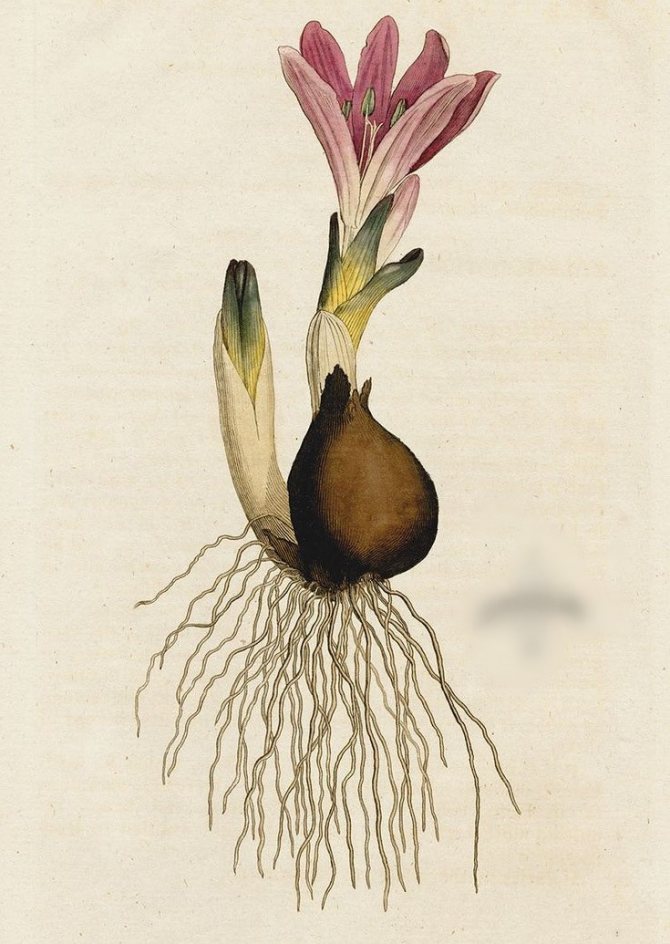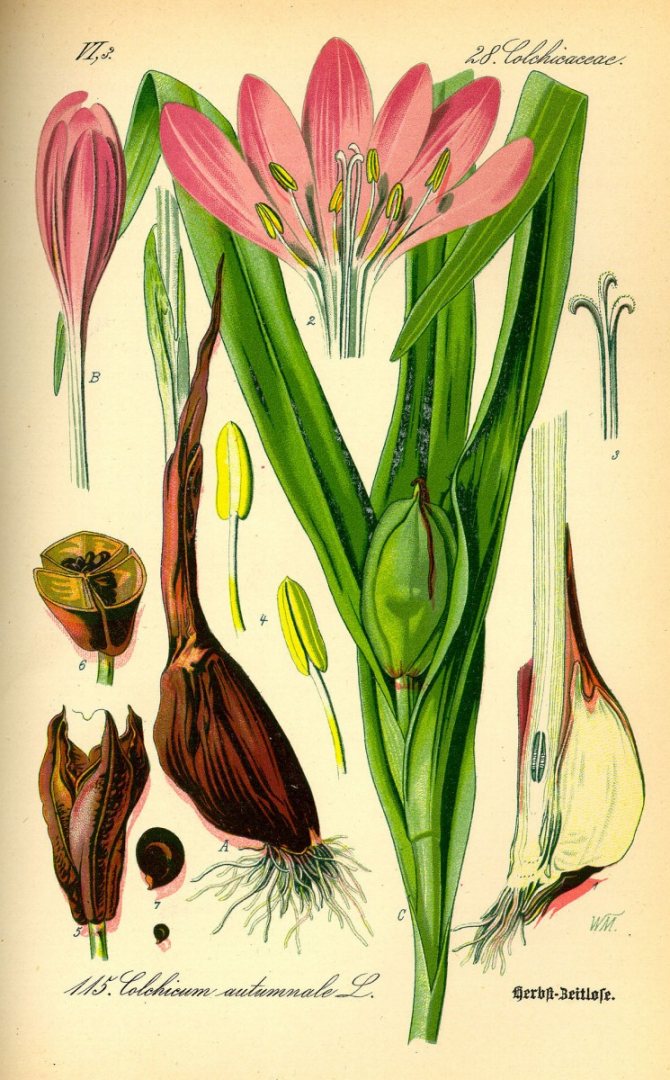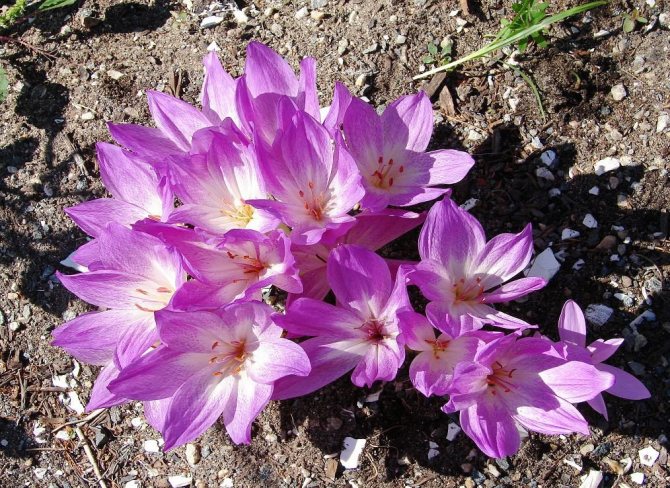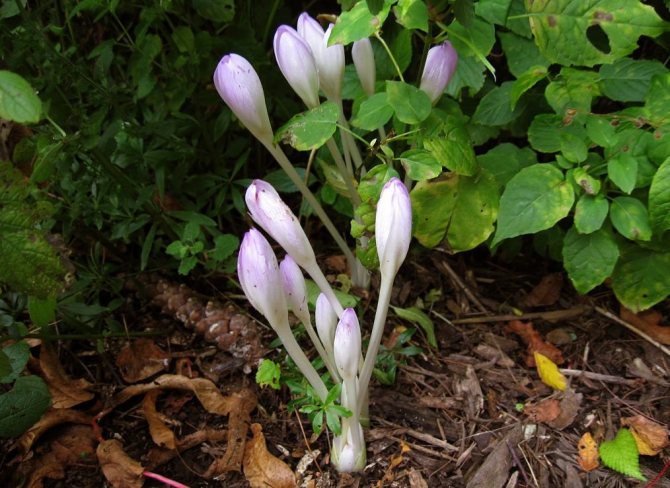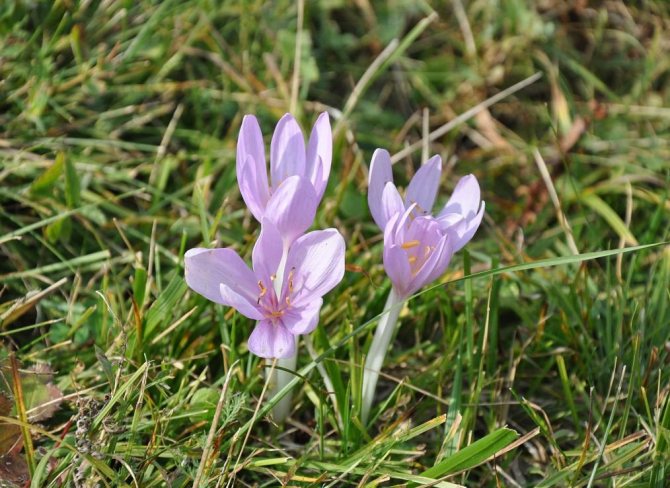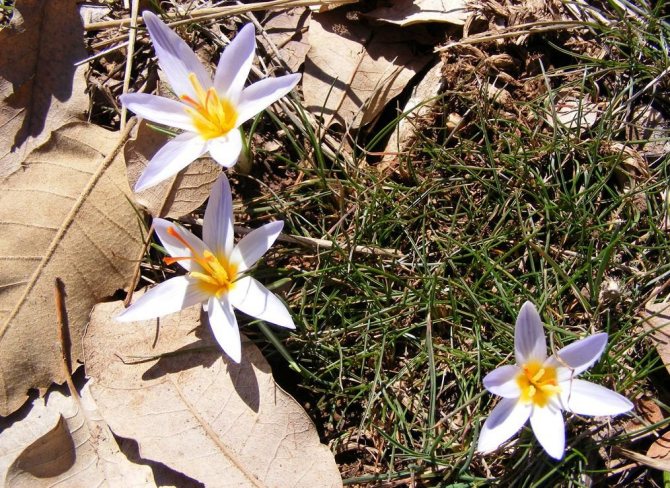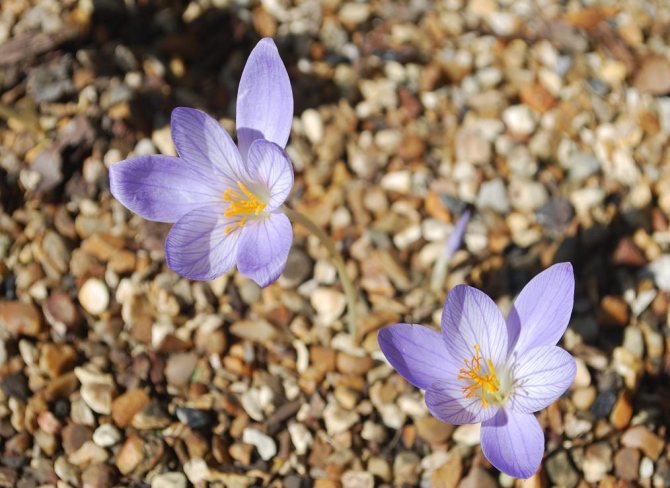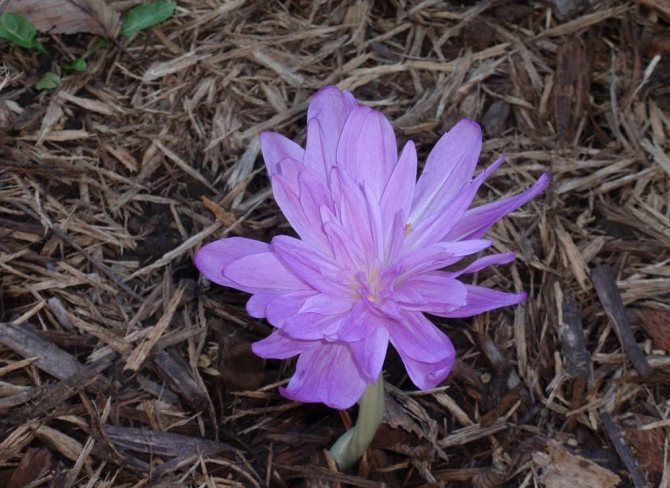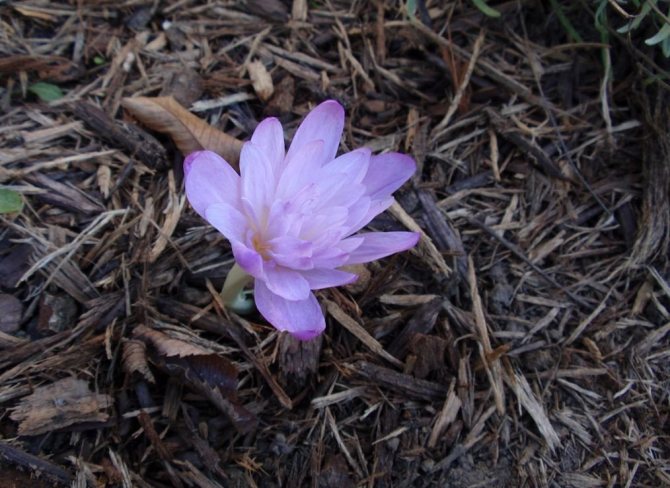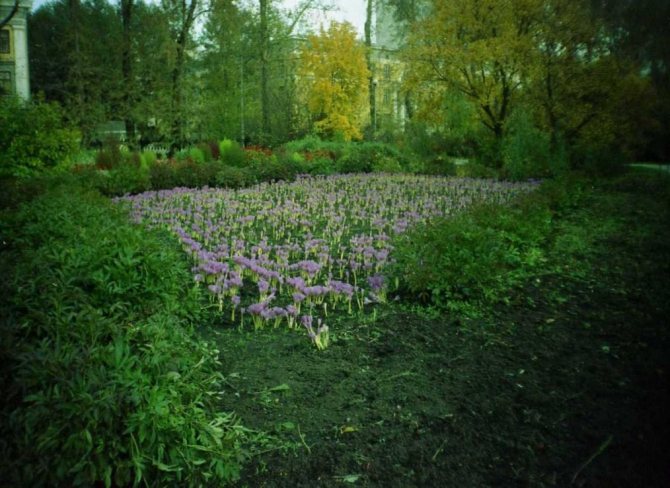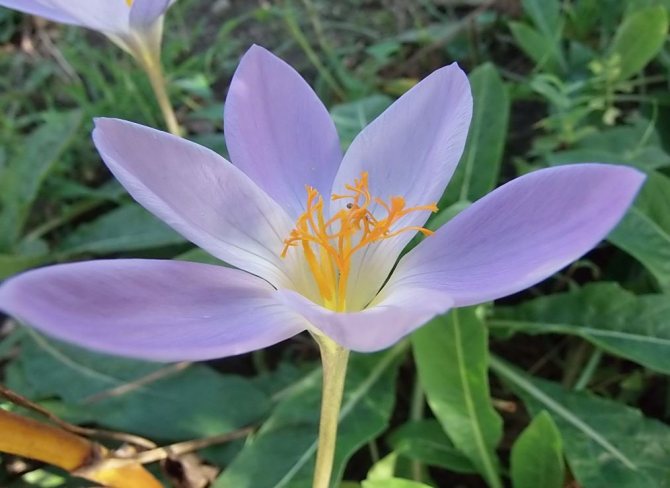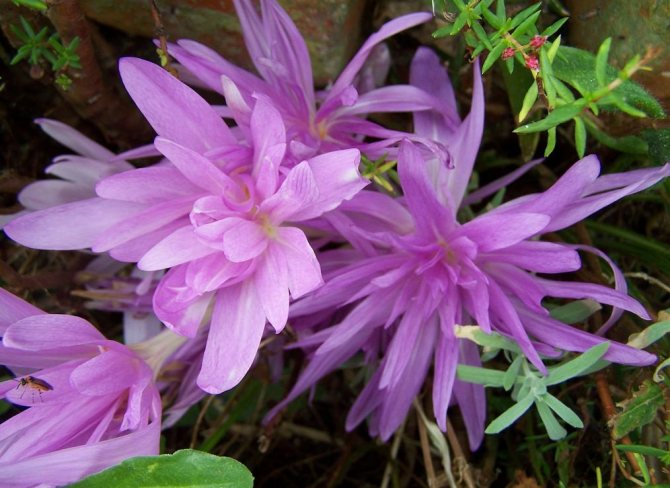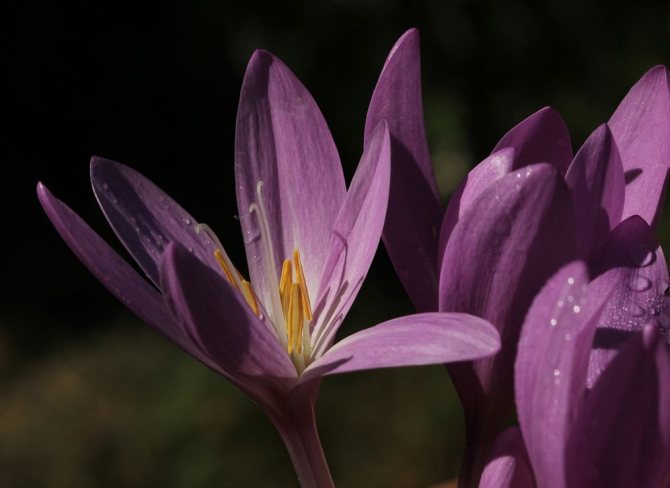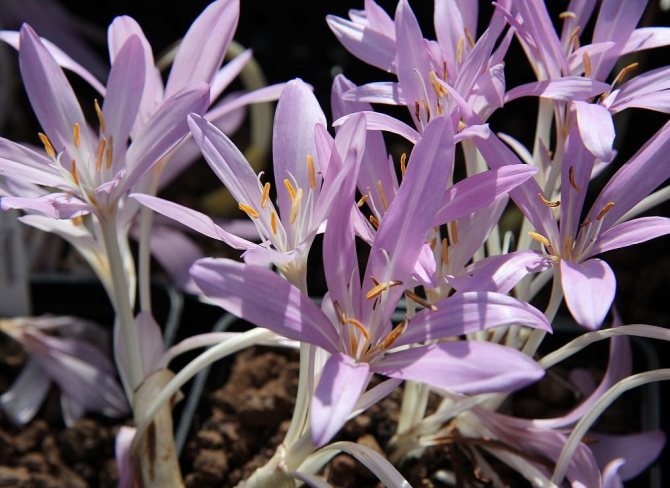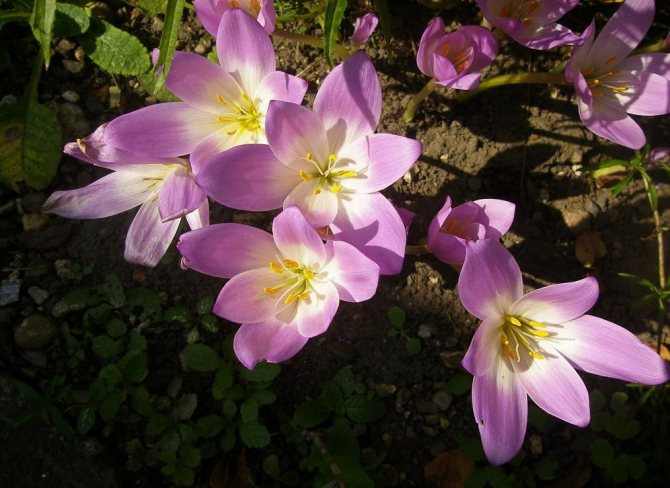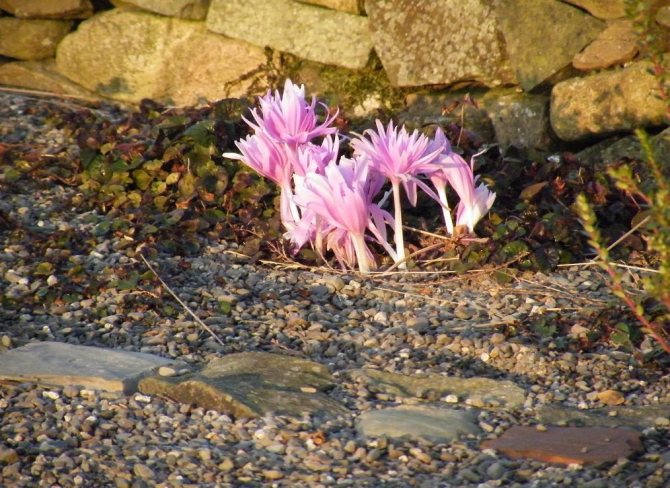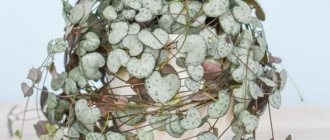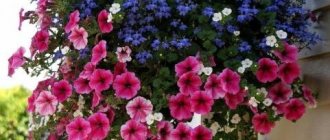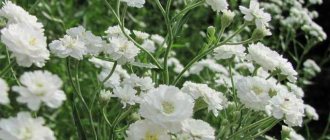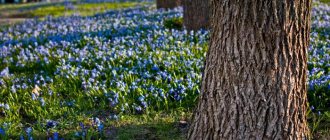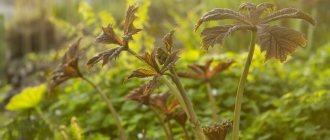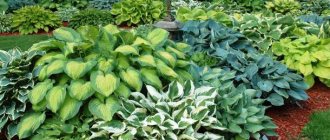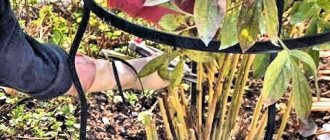Colchicum is also called colchicum, as well as autumnal. It is related to the genus of flowering perennial plants of the columbia family. Under natural conditions, such a plant can be found in Western and Central Asia, North Africa, Europe and the Mediterranean. This genus unites about 70 species of various plants. The Latin name for such a plant comes from the word "Colchis", which translates as "Colchis" - an area in the Black Sea region, the fact is that there you can meet several types of colchicum. The people call such a plant "timeless color" or "autumn color", and all because there are several types of crocus flowers that bloom in late autumn. Such a flower is cultivated in all areas where there is a temperate climate.
Variety of names
The name of this genus of plants - Kolhikum - has ancient Greek roots. The birthplace of flowers is Colchis, the historical region of the Black Sea. The following names of the plant are more common among the people: "autumn color", "crocus". This is due to the fact that most species bloom in late autumn, and in the spring a box with seeds develops from last year's "autumn" ovary.
Many people mistakenly call the colchicum "wintering" ("hellebore"). This is a completely different plant from a different family.
The meaning and application of kolchikum
Colchicum autumnalis is one of the oldest medicines, the healing properties of which were described by ancient Greek healers. Practically all parts of plants are used for medicinal purposes, except for leaves and stems. Corms are harvested before flowering, flowers during flowering, and seeds during ripening.
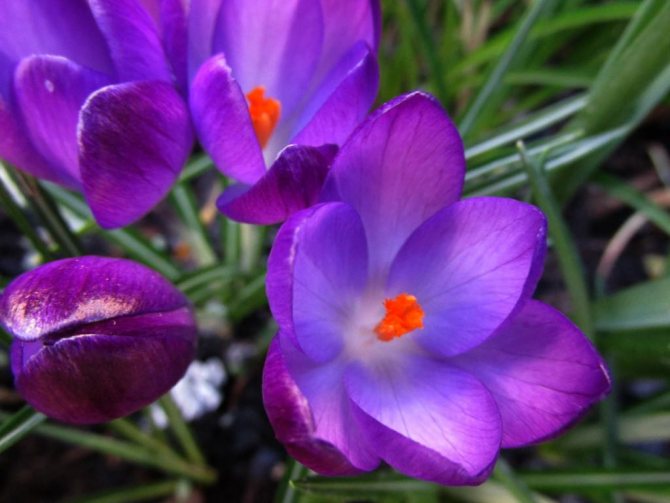
Flowers
Contains alkaloids, including rare active compounds of colchamine and colchicine, flavonoids, organic acids and resinous substances. Colhamin is a potent antiblastoma agent, therefore it is used to treat skin cancer and inoperable cancers of the digestive tract. Externally, colhamin ointment is taken to treat various forms of rheumatism and gout. Decoctions are taken for inflammatory processes of the stomach and intestines, for the treatment of neuralgic devices and circulatory disorders. In no case should you take medications, decoctions and tinctures for self-medication.
Colchicum is a poisonous plant that is a capillary poison that acts on living tissues according to the principle of arsenic. Therefore, colchicum is called vegetable arsenic. Cases of poisoning of farm animals during grazing on autumn pastures are known. When a plant enters the feed for cows, poisonous compounds also enter the milk, the use of which leads to poisoning.
Is it always poisonous?
Flowers, stem and roots of the crocus are poisonous. However, many medicines contain components of poisonous herbs and plants. And the crocus is no exception.
Its constituent lipids, tannins, resins and alkaloids successfully fight vomiting, diseases of the urinary tract and intestines. Infusions and ointments based on colchicum are used as analgesics in traditional medicine.
But before using drugs that include this plant, you must definitely consult a doctor, since an incorrectly selected dose and uncontrolled intake can end very badly.
Healing properties
Colchicum bulbs and seeds contain alkaloids, sugars, flavonoids and essential oils. Preparations from them are used in folk and traditional medicine as an anesthetic, diuretic, laxative and emetic. Alkaloids help lower blood pressure and help prevent the development of cancerous tumors.
We must not forget that all parts of the plant are very poisonous. In case of an overdose, severe poisoning is possible, and contact with fresh juice on the skin causes a burn. Before using drugs from colchicum, you should consult your doctor.
Many types of Kolhikum
There are about 70 species of plants of the Colorado genus. And here there are several of the brightest representatives of "autumn color", which summer residents and gardeners use to decorate their plots:
- colchicum byzantinum (colchicum byzantinum)... This miracle blooms from late August to late autumn and spring. One bulb head produces up to 14 flowers of a lilac-pink hue;
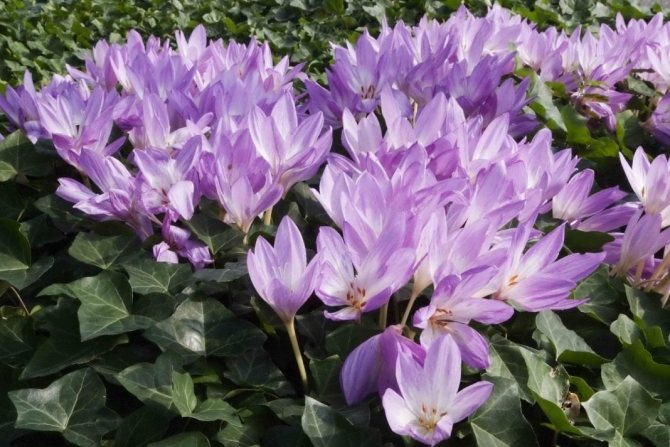

- colchicum cilicum... This species is found in Turkish areas. It is the tallest of all types of colchicum: its height can reach 60 cm. By the way, it also produces the largest number of flowers - up to 25, but blooms only in late autumn. The color of the flowers is similar to the Byzantine species;
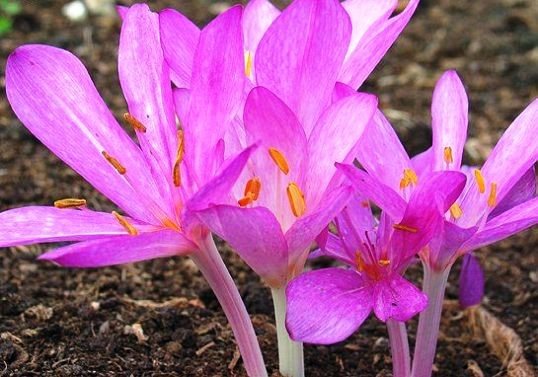

- colchicum magnificent (colchicum speciozum)... It is found in the western-eastern regions of the Transcaucasia and Ciscaucasia, as well as in the mountainous regions of the Caucasus Range. Mostly on forest edges. The only species that has few varieties. Among them, there are quite extraordinary ones - Water Lily (water lily), which belongs to the terry varieties. Plants of this species, 30 cm high, have “exotic” colors - striped or “checkerboard”;


- colchicum Bornmuelleri... Grows in Iranian regions and in the highlands of Asia. Very light-loving, blooms in September on loose and fertile soils;
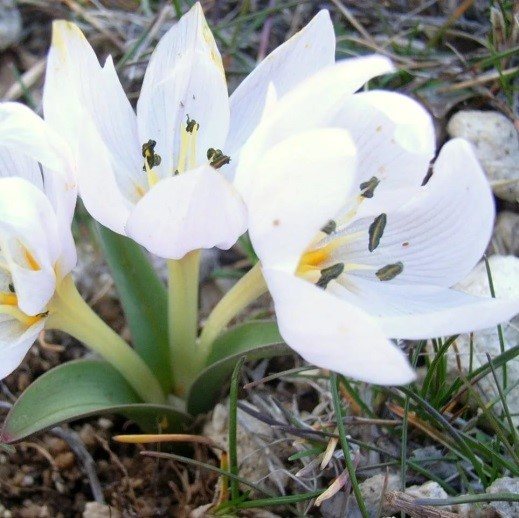

- Fomin's "autumn color" (colchicum fominii)... The only species listed in the Red Book and living exclusively in the Ukrainian open spaces. Despite the rarity, it is very picky and blooms from late August to late October.
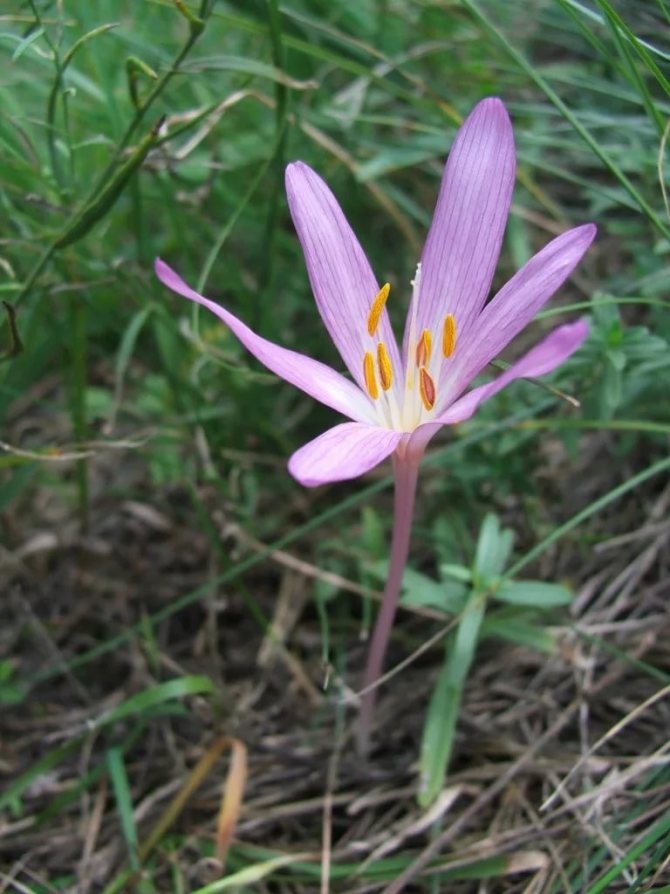

Features of crocus


Such a herb is a perennial, and it is also an ephemeroid. It has a large number of short shoots on which large lanceolate-elongated leaf plates are located. They grow and develop during the spring, and by the beginning of the summer period they completely die off. On the surface of the corms there is a brown shell. This shell forms a long tube that encloses the lower part of the flower. Most of the colchicum species bloom in the spring. However, in some species, flowering occurs in the spring. Single funnel-shaped flowers grow from the soil. The length of such a flower, together with the perianth that has grown into a tube (most of it is located under the soil surface), is 20 centimeters. The fruit is a three-celled oval spherical capsule. Such a plant contains poison, Dioscorides himself mentioned this in his works. It should be remembered that the poison is in any part of the plant.
Planting beauty
Colchicum this plant was called because it blooms in one place for 6-7 years, without requiring special care, moreover, the flowering period is unusual for such a bulbous. These flowers usually appear in early spring rather than fall.
After the expiration of the 6-7-year period, the bulbs of the colchicum grow "in breadth", and the flowers become smaller. However, now - about the landing.
Colchicum bulbs are planted towards the end of August, in loose soil, preferably black soil.
It is best to thoroughly fertilize the soil with ash and superphosphate before planting. Due to this, the crocus will bloom better and will more easily endure the winter cold.
Depending on the size, the bulbs are planted at different depths and at different distances from each other:
- for large bulbs, the depth will be 12-15 cm, and the distance from each other is 20-25 cm ...
- and small ones are placed in the soil 6-8 cm with a distance of 10-15 cm.
It must be remembered that absolutely all parts of the crocus are poisonous, therefore, garden mittens must be worn before planting or caring for this plant.
Description of the plant
Colchicum is a bulbous perennial plant. The height of the vegetation is 5-20 cm. The ground part is renewed annually, it consists of succulent herbaceous shoots. The oblong shapeless bulb has a creamy, almost white, core and is covered with dark brown scales. Its length is 3-5 cm. Long narrow lanceolate leaves appear in early spring. They are colored bright green and form a dense rosette. The length of a smooth leaf plate is 20-30 cm. A seed capsule appears from its center. The reddish-brown seeds are formed from the ovaries of the previous year. They ripen by the end of May, after which the capsule opens and the seeds are carried by the wind.
Most varieties of colchicum begin to bloom in September. Even frost or unexpected snowfall will not be an obstacle. One bulb can produce several flowers per season. Naked erect peduncles grow directly from the ground. The height of the plant together with the flower reaches 25 cm. More than half of the height is occupied by the corolla itself in the form of a glass. The large, fragrant flowers consist of lanceolate or ovoid petals. The color of flowers can be snow-white, cream, pink, lilac or purple. There are species with simple and double corollas. Flowering lasts about 3 weeks, after which the plant dries up completely.
Autumn color care
Although the crocus is unpretentious, however, there are several points that should not be overlooked:
- Slugs and snails... As a rule, they eat the flowers of plants in damp soil or in the shade, so these mammals need to be eradicated periodically. Slugs will have their hands (with gloves, of course), and snails - with special traps, or molluscicides.
- Pruning plant unnecessarily, although some ignorant flower growers cut off dried flowers in the autumn, and this is not good. For greater productivity, the crocus needs all its vital juices, so experienced gardeners do not prune.
- Watering Colchicum is also not needed, since the bulbs can rot. This procedure is appropriate during the period of its flowering, and then - if the weather is dry.
- In spring it is very desirable feed colchicums with nitrogen fertilizers so that they are saturated with useful substances.
- TO light are neutral: they feel equally good both in the sun and in the shade.
Of course, weeding is included in the list of mandatory and regular activities.
Life Cycle Calendar
Colchicum adheres to very unusual life cycles. They are laid down by the natural conditions of the flower's native places. Plants capable of adapting their life to natural cycles are called "ephemeroids". Cold and dry winters, as well as sizzling summer heat, do not favor the active growth of herbaceous shoots.
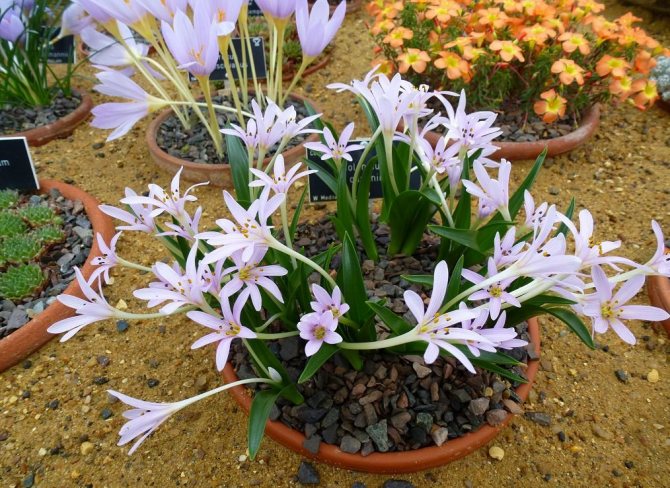

With the spring thaw, the crocus wakes up and releases green shoots with leaves. At the same time, a fruit appears in which the seeds ripen. This period is called the growing season. The green part is involved in photosynthesis and saturates the bulb with nutrients for the entire next year. Already at the beginning of June, all shoots dry up and a dormant period begins.
Reawakening occurs in September.Suddenly, from under the fallen foliage, large flowers with a heady aroma make their way. They last 2-3 weeks. The new growth develops entirely from the supply of food in the bulb. There is an ovary inside the bulb, which will be reliably covered throughout the winter. After flowering, the crocus falls asleep again until spring.
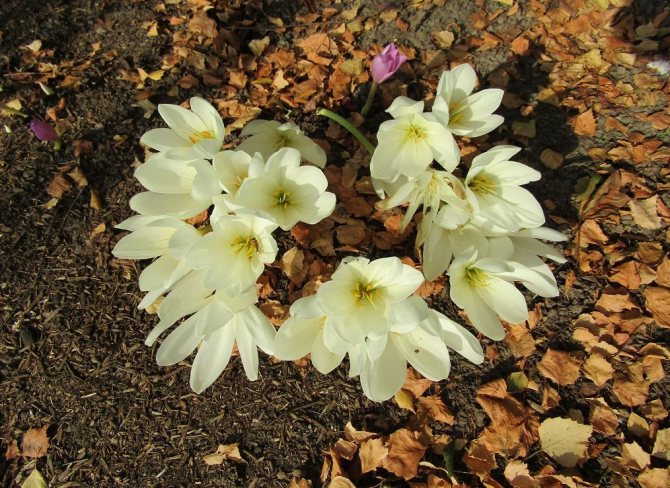

"Winter" and forcing Russian crocuses
Colchicum tolerates winter very well. But among these plants there are those who are not very resistant to frost. These are "terry" varieties. Therefore, they need cover for the winter with non-woven material, or dry foliage.
Many people want to admire these flowers not only in spring and autumn, but also in winter. This is possible when performing some simple manipulations:
- In the summer, carefully dig up the corms;
- Dry them thoroughly and put them in a dark place;
- A month before flowering, plant in wooden boxes with prepared soil;
- Keep in the shade, periodically watering, until sprouts appear;
- When the sprouts have appeared, take out the boxes and put them in a sunny place;
- Admire the result;
- After the complete flowering of the colchicum, remove the boxes with the bulbs in a cool place.
Several flowers can appear from one bulb, so you need to carefully monitor the flowering period
The ideal option would be to dig in such a box in the garden until next winter. If the action takes place in an apartment, then you can take the boxes out onto the balcony.
Main types and varieties with photos
Most of the crocus species bloom in autumn. However, there are some species that bloom in early spring, but they are not so popular with gardeners.
Spring blooming
Colchicum yellow (Colchicum luteum)


In natural conditions, this species prefers to grow in the edges of the rocky glaciers of the Himalayas, Pamir, Tien Shan and Tibet. It has been cultivated since 1882. The flowering of such a plant begins immediately after the snow cover melts. Flowers of three centimeters in diameter have a deep yellow color, while their height is no more than 15 centimeters. The flat leaf plates, colored dark green, grow at the same time as the flowers.
Colchicum hungaricum (Colchicum hungaricum)


Hungary is considered the birthplace of such a flower, but it can also be found in Greece, Albania, and also in the territory of the former Yugoslavia. Flowering occurs in late winter or early spring. Pink-purple or white flowers have maroon anthers. The upper part and edge of the leaf plates, which grow while the plant is blooming, have a dense coating of hairs on their surface. The most popular variety is Velebit Star.
Colchicum Ankara, or three-leafed, or Biberstein (Colchicum ancyrense, Colchicum biebersteimi, Colchicum triphyllum)


This plant is considered the earliest ephemeroid. So, in some cases, its flowering begins in the last days of December, and ends in April. Under natural conditions, this species can be found in Moldova, in the southwestern regions of Ukraine, in the Crimea, as well as in the western regions of Turkey. Each specimen has 3 narrow, oblong, grooved leaves of a bluish color, the edge of which is ciliated, as well as from 2 to 4 flowers of pink-purple color.
Colchicum Regel, or Kesselring (Colchicum regelii, Colchicum crociflorum, Colchicum kesselringii)


Under natural conditions, it is most often found in subalpine and alpine belts, which are located at an altitude of at least 2 thousand meters above sea level. And you can also meet this kind in the Tien Shan and Pamirs. There is an oblong bulb and 2–7 obtuse grooved leaves, the edge of which is finely toothed or smooth. On the specimen, there are from 1 to 4 flowers of white color, on the seamy side of the lobes of the limbs there are violet-purple stripes. Flowering begins immediately after the snow cover melts.
And also popular among gardeners are such species as: Sovicha, water-loving and bunchy.
Autumn blooming
Autumn colchicum (Colchicum autumnale)


Prefers to grow in meadows and forest glades. Under natural conditions, this kind can be found in European countries from the Carpathians and Latvia to England and Western France. He is sometimes met at an altitude of more than 2 thousand meters above sea level. The bush of such a plant reaches a height of no more than 40 centimeters. Flat, erect, oblong-shaped leaf plates grow in spring, and by the beginning of summer they turn yellow and wither. One bulb grows from 1 to 4 flowers, painted in a pale lilac or white color, the diameter of which is 7 centimeters. The following forms are more popular:
- Autumn white - this form in natural conditions can be met infrequently. From the middle of September, 5–7 flowers appear on one bulb, the length of which is no more than 15 centimeters. Their center is yellow, and the perianth is snow-white.
- Autumn terry - the length of lilac flowers is about 12 centimeters, while their diameter is 5 centimeters. Each flower has many petals (about 35 pieces). The length of the dark green leaf plates is 25 centimeters, and their width is 4 centimeters. Flowering begins later than other species, namely, in the last days of October.
- Autumn white terry - each double white flower has about 45 petals. The plant blooms from mid-September.
- Autumn neddist - this form was brought out in the Czech Republic. The flowers are light pink.
And there are also such forms in which the flowers are painted in dark purple or purple. The flowers of the Baconsfield cultivar have a white center and a purplish pink color.
How do colchicums breed?
Reproduction takes place vegetatively - the "bulbous" method is used. This method is most effective: after a couple of years, the plant will begin to bloom.
First, you need to dig up the bulbs and clean them of soil, as well as old bulbs and leaves. You need to dig it out carefully, because the bulbs themselves are relatively deep - 30-35 cm underground.
The scales covering the tuber are never removed. This is a kind of "spacesuit" for the onion.
After all the manipulations, the bulbs are washed, etched with a manganese solution, and then dried in a dark, dry room at 24-degree temperature.
Reproduction of colchicum using seeds - not the best way, because it begins to bloom only 7 years after planting in the ground. Well, here the owner is the master. It is better to sow seeds in open ground at a shallow depth.
You can buy seeds and bulbs of colchicum at any seed store in your city or place an order online.
Pick up time and place
The best time for planting and transplanting croplands is August. The bulb during this period contains enough nutrients and is dormant. Kolhikum is undemanding to the landing site. This can be an open sunny area or light partial shade. However, it is not recommended to plant it under densely crowned trees. The lack of light for plants does not matter, but many slugs can live in shady, damp places.
Flowers grow best on loose, fertile soil, but they can adapt to other soils. Even heavy loams are not a problem for them. The acidity can also be anything. The only thing that the crocus does not tolerate is flooded, swampy areas. Medium and small bulbs are planted to a depth of 8-12 cm, and larger ones are buried by 20-25 cm. The edges of the scaly tube that sticks out of the bulb should look out at the surface. Since the bush will constantly grow in breadth, the distance between plantings should be at least 20 cm.
Before planting, the earth is dug up and large clods are broken.Mullein and superphosphate are recommended. If possible, heavy soil is mixed with sawdust and peat.
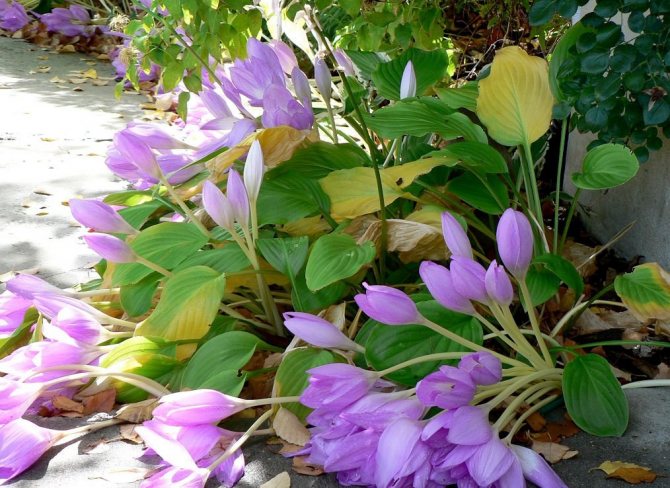

Wonderful garden decoration
In the decorative design of the garden, hybrid varieties of species are used. Colchicum looks good in rocky gardens, on "alpine hills", along water bodies, on lawns, as well as along paths and curbs. When planting an autumn crocus in a garden or on a plot, you need to remember two important rules:
- Do not water the plant. Colchicum bulbs love warmth and dryness and will bloom beautifully on their own.
- Kolhikum also has leaves. And they periodically "get bogged down" and spoil the whole picturesque view. The ideal option would be perennials planted nearby.
If the colchicums settled in your apartment, then it is better to plant them in glass vessels or terracotta pots with gravel, expanded clay or sand so that the bulbs of the colchicum are visible.
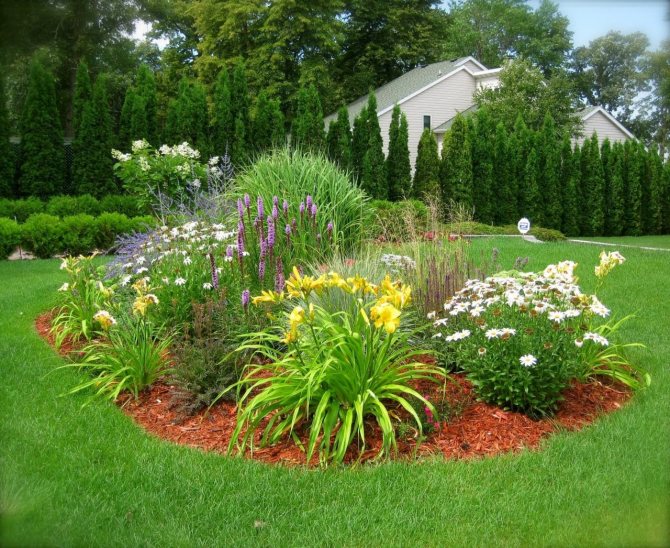

A variant of a summer flower bed in anticipation of croplands.
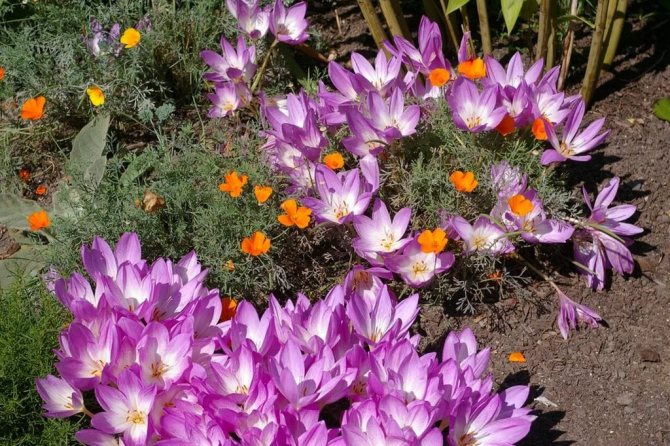

Colchicum on a personal plot
Despite the poisonous characteristics of colchicum, it is popular in the design of personal plots in flower beds, rock gardens, rockeries, borders, especially species such as autumn, bright and magnificent. With the onset of autumn, when most garden plants finish blooming and are covered with the first yellow foliage, contrary to traditional beliefs, colchicum begins to bloom. Thanks to this, the empty flower beds acquire new bright colors and delight the eye until the first snow.
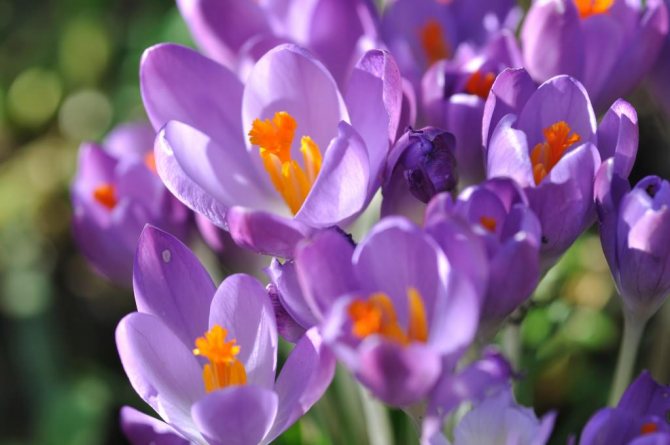

Color
With great care, it is necessary to plant in areas where small children walk, who like to taste everything, and animals. Since the ingestion of the plant in food can lead to severe forms of poisoning. But the toxicity of the plant also has its advantages, garden pests die when eaten without harming cultural plantings. All garden work with colchicum should be carried out with gloves.
It is unpretentious in care, grows well on moist, nutritious soils, well tolerates direct sunlight and partial shade. In the wild, it is magnificent, and thanks to the work of breeders, decorative varieties have appeared that differ from their wild-growing counterparts in a larger double shape and a variety of cream and white shades. Among gardeners, we purchased varieties such as Autumn, Agrippina, Jolly and Bornmüller. This plant can be planted in any part of the garden, but you need to take into account the peculiarities of this plant so that you do not have to plant it again next year.
Diseases and pests
The main pests of the crocus are snails and slugs. As a prophylaxis against these pests, flower growers are advised to lay out paths of eggshells, broken shells, small stones between the rows of plants. Around the perimeter or circumference of a flower bed or flower garden, you can place plastic gutters (made of plastic bottles or the remains of plastic pipes) with water, which will become a reliable barrier for uninvited guests eating the leaves.
A possible disease is gray rot. It can appear from excess moisture in the soil and constant excess watering. This fungal disease can completely destroy the entire flower garden, if rescue measures are not taken in time. At the initial stage, it is recommended to urgently treat flower crops with special preparations (for example, "Topaz", "Champion", "Kuproksat"), stop watering and destroy completely affected plants. In the future, it is necessary to strictly observe the requirements for watering and not forget about preventive measures.
About transplanting an autumn flower
This culture can safely be without transplant for up to seven years. Then a mandatory transplant is required. If you have got yourself a crocus, then it is best to transplant it once every three years. If tightened, the small bulbs will interfere with each other, the tightness will affect the size of the bulbs.
Colchicum should be planted or transplanted at the end of summer, that is, during rest.But the bulbs should be dug out earlier, immediately after the leaves turn yellow (second half of June).
The bulbs are carefully freed from the soil and removed all that is left of the leaves. Separate the daughter bulbs from the main (maternal) bulbs. It is important to remember that mothers are no longer used.
Next, the bulbous planting material is washed and kept for half an hour in a solution of potassium permanganate in order to disinfect them. Next, the bulbs are dried and removed for storage in a dark, non-humid room, where it is about 24 ° C. In August, daughter bulbs are planted in fertilized soil (see above for how to do this).
Where to buy colchicum bulbs
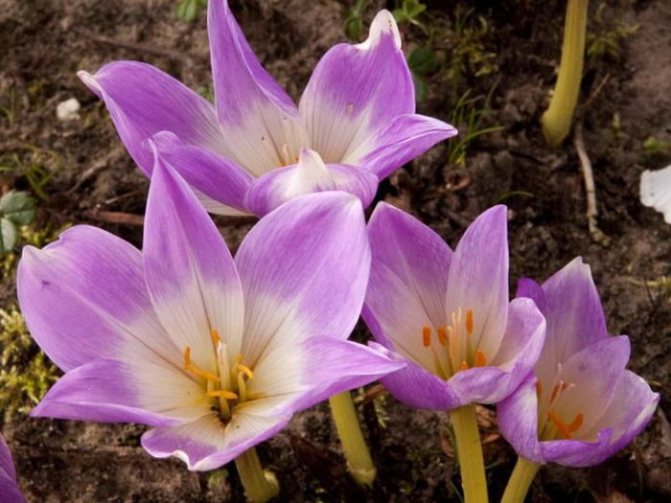

The Scientific and Production Association "Sady Rossii" has been introducing the latest achievements in the selection of vegetable, fruit, berry and ornamental crops into the wide practice of amateur gardening for 30 years. In the work of the association, the most modern technologies are used, a unique laboratory for microclonal reproduction of plants has been created. The main tasks of NPO Sady Rossii is to provide gardeners with high-quality planting material for popular varieties of various garden plants and novelties of world selection. Delivery of planting material (seeds, onions, seedlings) is carried out by Russian post. We are waiting for you for shopping: NPO "Sady Rossii"
[/ td]
Colchicum as a garden culture
Colchicum is a perennial horticultural crop that blooms in August-October. At this time, low peduncles with buds emerge from the corms, which, when blooming, turn into large flowers of a simple bell-shaped shape. They are characterized by a long tube and six bends. Their color can be white, cream, pink, lilac, lilac, violet or purple. Several yellow or bright red stamens emerge from the core of the flowers. By its structure, the flowers of the crocus resemble large crocuses. Flowering usually lasts up to three weeks. Hybrid varieties can be terry. The plant emits a light, elegant scent.
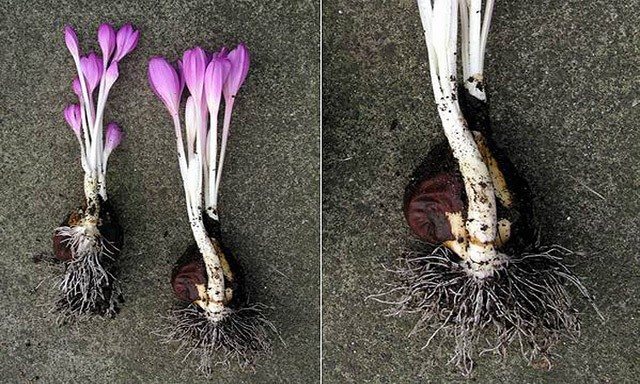

Up to 10 flowers grow from each bulb
In early spring, large, thick, leathery, bright green foliage of an elongated lanceolate shape appears from the soil, which grows up to 7 cm in length. In the middle of summer, it dries up, and during the spectacular flowering, the plants remain bare. For this feature in England, the crochet was jokingly nicknamed "the naked lady". Fruits formed after flowering are oval or diamond-shaped tricuspid capsules with reddish-brown seeds. To obtain seed, they are left to winter on the plant, since their full maturation occurs only at the beginning of the next summer.
Colchicum is completely unpretentious to growing conditions and blooms profusely both in sunny areas of the garden and in light shade. But you should not plant it under too spreading bushes, since in a strong shade it can be affected by various pests. Both acidic and alkaline soils are suitable for the crocus. But for better plant development, you need to choose a loose and nutritious soil. It must be well-drained, since with stagnant water, the flower bulbs quickly rot, which leads to the death of the crocus.
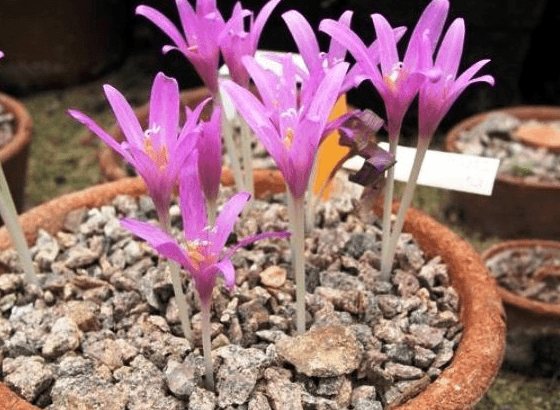

During the period of foliage and during the formation of buds, the crocus can be taken out to the balcony
In addition to open ground, this flower can be grown indoors, using small planters or pots for planting. Several bulbs are planted in one container. Overgrown plants are transplanted every three years. This should be done after the foliage dies off.
Due to its growth in the wild, the crocus is quite frost-resistant, hardy and undemanding to temperature conditions. Therefore, it can be grown outdoors in almost any region of our country.
Answers on questions
Due to the unusual growth of a flowering plant, many novice summer residents ask questions, to which they receive answers from knowledgeable people:
- Why did the flowers get smaller? Most likely, there was an increase in daughter bulbs. The tubers receive less nutrients, and they themselves are smaller, so the peduncles are smaller. Splitting the nest will help solve the problem. For this, in June, July, a plant is dug up, and in August they are planted in a new place.
- How often to transplant colchicum? Strong growth occurs in 4-5 years, therefore, by the fifth year, when about 12 peduncles appear from the ground, the plant must be transplanted.
- In what form can plant poisoning occur, and which parts of it are the most poisonous? Colchicum is poisonous in its entirety, from the bulb to the seeds. Eating 6 grams of seeds can cause irreversible reactions in adults, while the child can die. The first signs are vomiting, diarrhea, lymphocytosis. Therefore, in order to protect yourself and your household, you should not dry and keep the bulbs in an accessible place, and when the plant has come to the surface, they make sure that the children do not approach the flower bed.
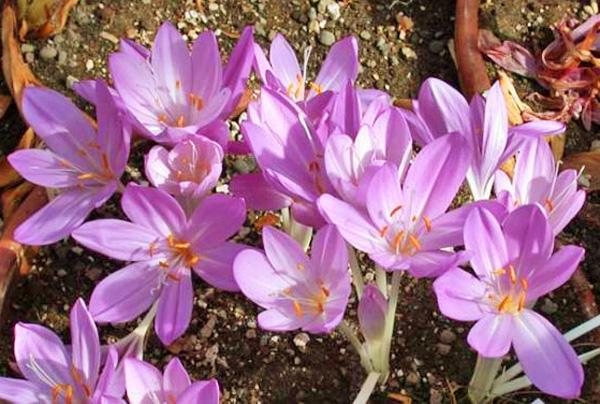

Use in landscape design. Examples in the photo
Due to the timing of flowering, the beauty of foliage and buds and unpretentious care, the crocus has long gained great popularity in the design of garden plots. Since it can grow almost anywhere, it can be used in a wide variety of plantings, both group and single.
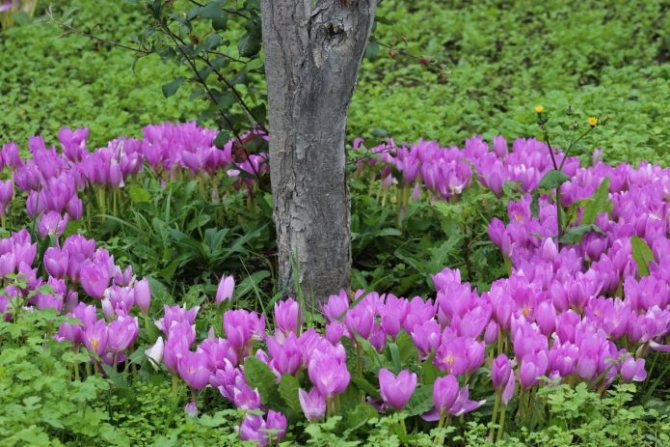

Colchicum around the tree
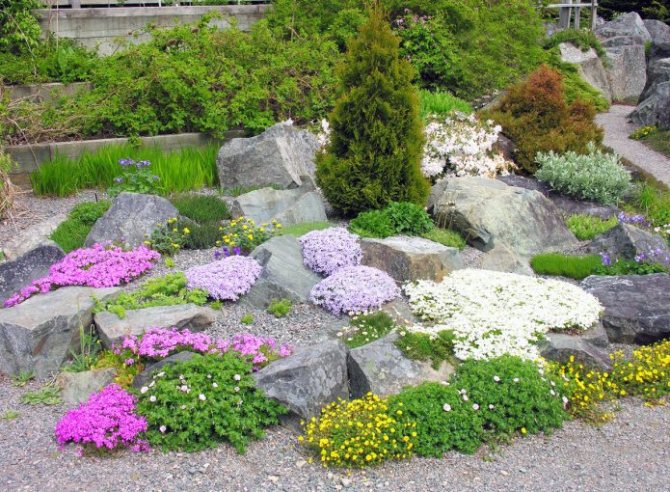

Colchicum in garden design
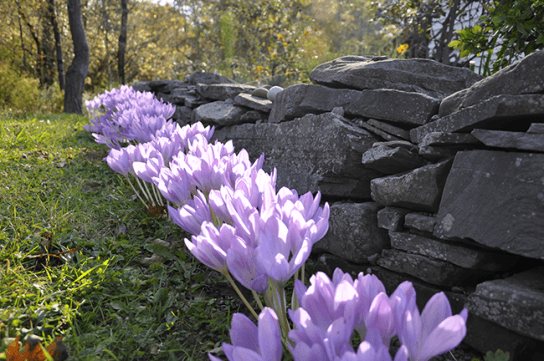

Colchicum in the shade
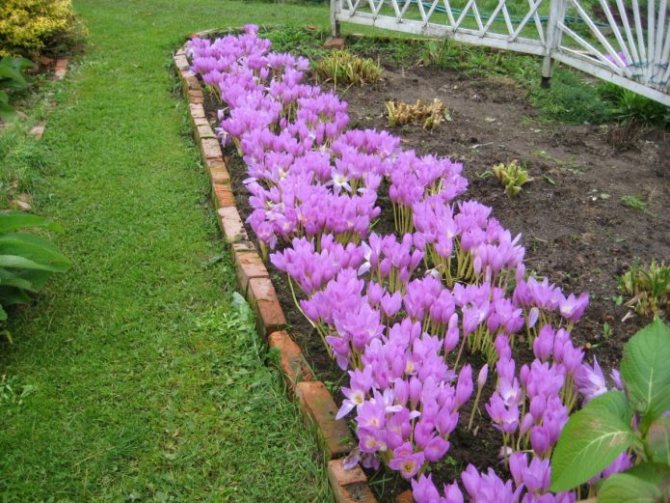

Colchicum at the curb
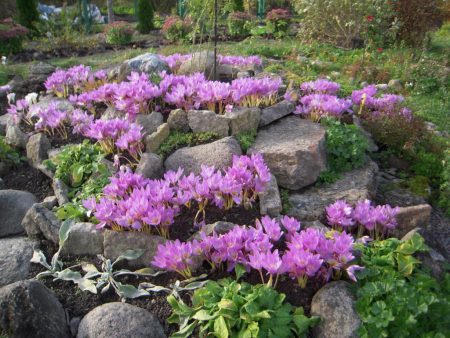

Colchicum on a rock garden
Since the foliage of the crocus dies off already in June, and the flower stalks appear only in early autumn, in group plantings it is recommended to combine it with light creeping plants, for example, tenacious, periwinkle, yaskolka, spring navel, hornbeam. They will help mask dead foliage. It is also recommended to place plantings of crocus near low perennials, for example, peonies, aubriets, Iberis, Acena, irises, Canadian phlox. Blooming crockery planted near coniferous bushes (juniper, cypress and others) looks very beautiful.
Seed growing of flowers
From seeds, colchicum grows slowly. Growing a flower in this way is carried out as follows:
- Plow the land, cover it with sand. Sow flower seeds into prepared soil;
- During the warm season, keep the soil moist for several days;
- It is advisable to leave the seeds in the open air so that they are imbued with the summer heat and also be able to survive the temperature fluctuations.
Colchicum is autumn, the crocus is magnificent, as well as other plant species germinate within two years after the moment they are planted from seeds.
To help the seeds germinate better, they must first be planted in a warm, humid period, and then in a cool season with temperature changes. It is recommended to store seedlings in a dark place. Seed colchicum blooms only five years after sowing.
Cultivation of crocus from seeds
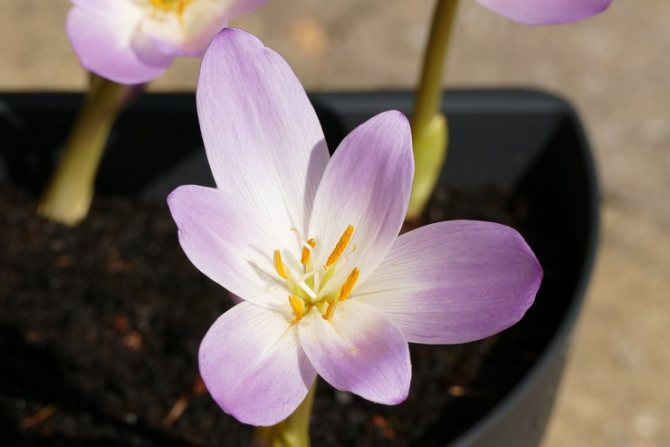

The seed method of reproduction of crocus can be confidently called a laborious and troublesome process, which will give its results only after 5-6 years. It is after such a period of time that the bulb will gain enough strength to give the first flowering. And not all species of this flowering culture can reproduce in this way.
Ideal when seeds are sown immediately after harvest during the summer months. In this case, it is enough to soak them in ordinary water at room temperature for 30-40 minutes before burying them in the ground. The first seedlings can be expected in the coming spring season. If not freshly harvested seed material is used for planting, then it will require long-term stratification.For 5-6 months, the seeds should be stored on the bottom shelf of the refrigerator.
Seeds are sown to a depth of 5-10 mm. The nutrient soil must be pre-moistened and loosened. It is also recommended to use a drainage layer covered with a small amount of sand.
Basic care requires regular moistening of the soil from a fine sprayer (without excess moisture), timely loosening of the soil, removal of weeds, and thinning. When the young foliage dies off at the end of the warm season, it is necessary to apply a mulch layer that will protect the plantings from the cold in the autumn-winter period.
Autumnal, colchicum, colchicum - it's all about one plant
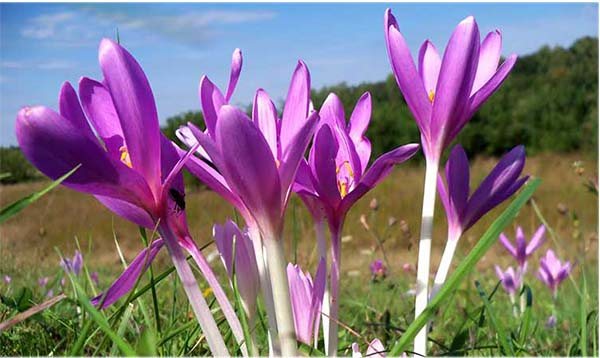

Autumn crocus
Due to the fact that the historical homeland of the flower is one of the regions of Western Georgia - Colchis, it received another name: "Kolkhikum". In general, this perennial is rich in names! Do not be surprised if you come across such a plant name as "autumn" or "autumn", this is due to the time of flowering. Europeans are accustomed to call it meadow saffron, and the British associated the name with the fact that flowers appear on it in the absence of leaves. Therefore, the people of Britain often call him "the naked lady".
We will acquaint you with an interesting plant, tell you how to breed and care for it.

